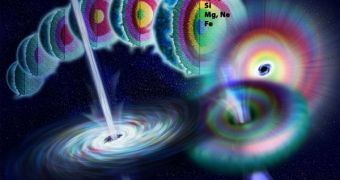The NASA American space agency has recently identified, through its SWIFT satellite, the oldest-ever-detected gamma-ray burst (GRB) in the Universe, originating some 630 million years after the Big Bang. This means that the star that collapsed to generate the GRB ended its life cycle a good 370 million years before the end of the reionization epoch, when the vastness of space started getting more populated with galaxies, black holes, dark matter, gas and dust. The detected emission, cataloged GRB 090423, comes from a time when the Universe was only about five percent its current age.
“Swift was designed to catch these very distant bursts. The incredible distance to this burst exceeded our greatest expectations – it was a true blast from the past,” Neil Gehrels, who is the lead scientists for the Swift mission at the Goddard Space Flight Center, in Greenbelt, Maryland, says in a press release on NASA's website.
He explains that the satellite detected signs of the old burst on April 23rd, and that, upon sensing it, the machine quickly turned all of its instruments, including ultraviolet/optical and X-ray telescopes, towards it. The GRB lasted for about ten seconds, and was of modest intensity, but the Swift satellite managed to get a good look at its origins.
The afterglow from the burst could only be identified in faint X-ray readings, whereas optical and ultraviolet scans revealed nothing. Harvard University space expert Edo Berger, who is a member of the Swift team, says that, “The lack of visible light alone suggested this could be a very distant object.” And later readings, indeed, seemed to confirm these suspicions. “The burst most likely arose from the explosion of a massive star. We're seeing the demise of a star – and probably the birth of a black hole – in one of the universe's earliest stellar generations,” Pennsylvania State University expert Derek Fox shares in the same press release.
“If you look far enough away, you can't see visible light from any object,” Berger notes. When using the Gemini North Telescope on Mauna Kea, Hawaii, to peer at the origin of the GRB, experts in charge of the observatory had little luck in seeing it, even though they photographed the location in the 1-micron wavelength. The source of the bursts appeared only in longer-wavelength images, which implies that it was more than 13 billion years away. After complex astronomical calculations, astronomers concluded that the massive star, which generated the GRB, existed some 13.035 billion light-years away.
“It's an incredible find. What makes it even better is that a telescope named for Galileo made this measurement during the year in which we celebrate the 400th anniversary of Galileo's first astronomical use of the telescope,” Italian researcher Guido Chincarini, from the University of Milan-Bicocca, which has been part of the team that used the Galileo National Telescope on La Palma in the Canary Islands to peer at the GRB 090423 source, concludes.

 14 DAY TRIAL //
14 DAY TRIAL //